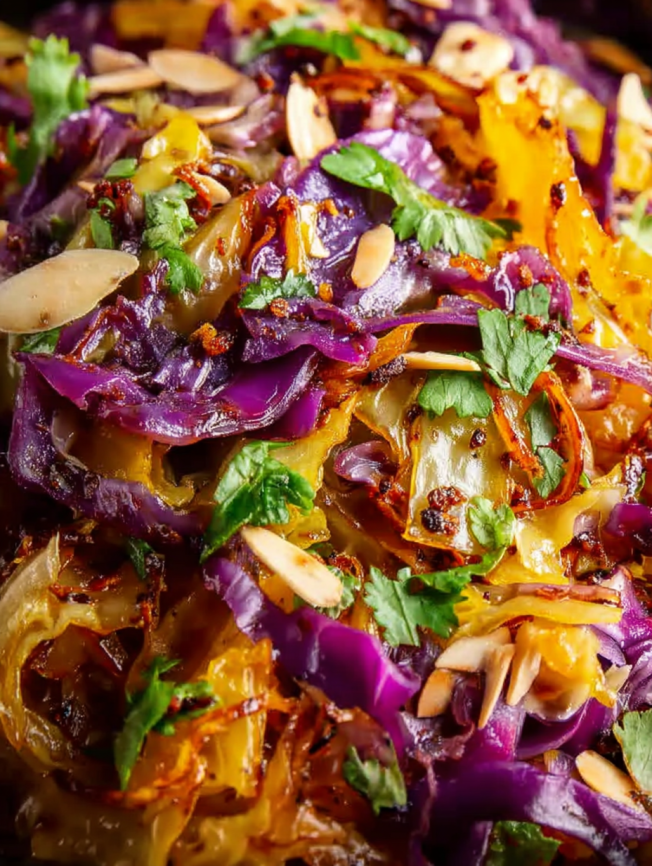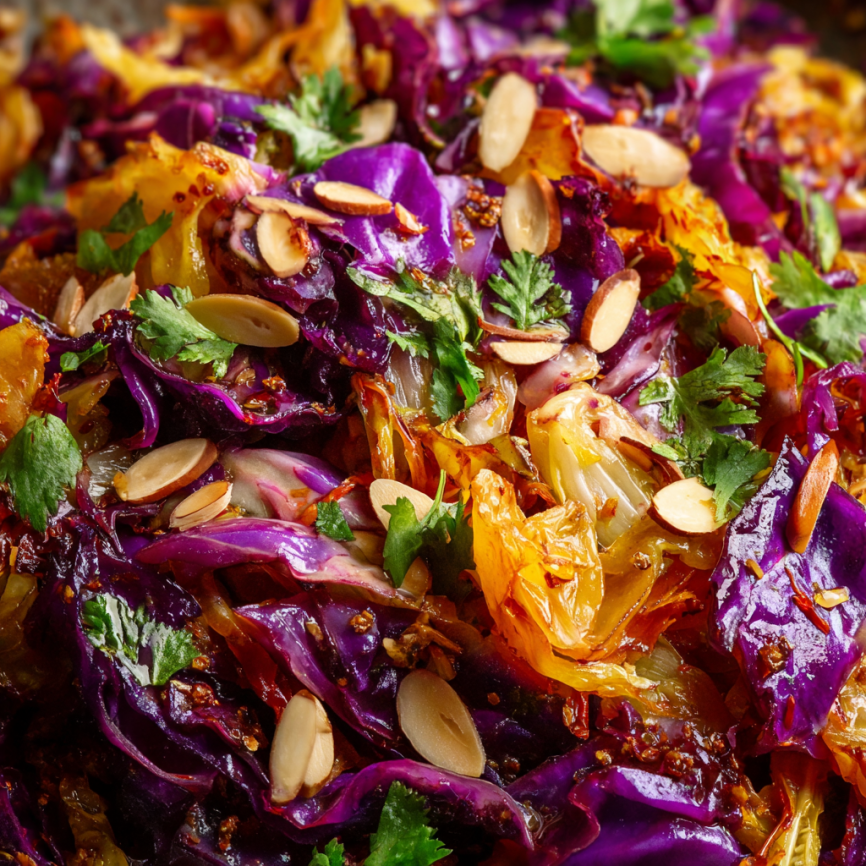Prep Time: 10 minutes | Cooking Time: 20 minutes | Total Time: 30 minutes
Calories: 146 kcal per serving | Servings: 6 portions
Growing up, the aroma of sizzling spices and curry leaves always signaled that something magical was happening in our kitchen. This Indian Spiced Roasted Cabbage brings back those cherished memories while offering a modern twist on the beloved South Indian “cabbage poriyal.” What makes this recipe truly special is how the oven transforms humble cabbage into something extraordinary – crispy edges, tender centers, and an explosion of aromatic flavors that will transport you straight to the spice markets of Kerala.
Unlike traditional stovetop methods that require constant stirring, this hands-off approach allows the natural sweetness of cabbage to caramelize beautifully. Meanwhile, the warm spices infuse every bite with authentic Indian flavors. Whether you’re new to Indian cuisine or a seasoned enthusiast, this dish will become your go-to side that’s both comforting and exciting.
Why You’ll Fall in Love with This Recipe
Effortless Preparation
Busy weeknights call for simple solutions, and this recipe delivers exactly that. With just 10 minutes of prep time, you can have a restaurant-quality dish ready in half an hour. The oven does most of the work while you focus on other meal components.
Nutritional Powerhouse
Cabbage often gets overlooked, but it’s actually a nutritional superstar. Packed with vitamin C, fiber, and antioxidants, this cruciferous vegetable supports everything from immune function to digestive health. Furthermore, the addition of turmeric and other spices boosts the anti-inflammatory benefits significantly.
Diet-Friendly Versatility
Whether you follow vegan, gluten-free, or plant-based eating patterns, this dish fits seamlessly into your lifestyle. Additionally, it’s naturally low in calories while being incredibly satisfying – perfect for those watching their weight without sacrificing flavor.
Authentic Flavor Profile
Each spice in this recipe serves a purpose, creating layers of flavor that complement rather than compete with each other. The result is a dish that tastes like it came from a traditional South Indian kitchen, complete with the signature coconut finish that makes poriyal so distinctive.
Essential Ingredients
Main Components
- 3 tablespoons peanut oil or sesame oil – Creates the aromatic base
- 1 inch fresh ginger, grated (about 2 teaspoons) – Adds warmth and zing
- 1 tablespoon chopped green chilies – Provides gentle heat (adjust to taste)
- 1 teaspoon cumin seeds – Brings nutty, earthy notes
- ½ teaspoon turmeric – Offers golden color and anti-inflammatory benefits
- ½ teaspoon red pepper flakes (or ¼ teaspoon cayenne) – Delivers subtle spice
- Salt to taste – Enhances all other flavors
- 4 cups shredded cabbage – The star ingredient
- 1 cup shredded carrots – Adds sweetness and vibrant color
- 8-10 curry leaves – Provides authentic South Indian aroma
- ¼ cup fresh grated coconut – Creates the signature poriyal finish
- 2 tablespoons chopped cilantro – Brings freshness
- Lemon juice to taste – Brightens the entire dish
Optional Flavor Enhancers
- ½ teaspoon mustard seeds – Traditional tempering ingredient
- ¼ cup chopped shallots or onions – Adds depth and sweetness
- 4 tablespoons crushed roasted peanuts or sesame seeds – Provides textural contrast
Step-by-Step Cooking Instructions
Preparation Phase
Begin by preheating your oven to 400°F (200°C). This temperature ensures proper caramelization without burning the delicate spices. Meanwhile, gather all your ingredients and have them measured and ready – Indian cooking moves quickly once you start.
Creating the Spice Base
In a large mixing bowl, combine the peanut oil with grated ginger, chopped green chilies, cumin seeds, turmeric, and red pepper flakes. Add salt to taste and whisk everything together until well incorporated. This aromatic paste will coat every piece of cabbage with flavor.
Combining Vegetables
Add the shredded cabbage, carrots, and curry leaves to your spice mixture. Using clean hands or large spoons, toss everything thoroughly until every strand of cabbage glistens with the golden spice oil. Take your time with this step – proper coating ensures even flavoring throughout.
Roasting Process
Spread the seasoned vegetables evenly across a parchment-lined baking sheet. Avoid overcrowding, which can lead to steaming instead of roasting. Place in the preheated oven and roast for 20-25 minutes, stirring once halfway through to promote even browning.
Final Touches
Once the cabbage edges turn golden and the vegetables are tender, remove from the oven. Immediately sprinkle with fresh grated coconut, chopped cilantro, and a squeeze of lemon juice. Toss gently while still warm to allow the coconut to toast slightly from residual heat.

Perfect Serving Suggestions
Traditional Pairings
This roasted cabbage shines alongside steamed basmati rice and dal (lentil curry). The mild, fluffy rice provides the perfect backdrop for the bold spices, while protein-rich dal creates a complete, balanced meal.
Modern Adaptations
Consider serving over quinoa for added protein, or alongside grilled chicken for those who eat meat. The dish also works beautifully as a warm salad topped with additional nuts and seeds.
Bread Companions
Indian flatbreads like roti, naan, or even simple pita bread make excellent vehicles for scooping up this flavorful cabbage. The combination of textures creates a satisfying, handheld meal option.
Creative Recipe Variations
Protein Additions
Transform this side dish into a main course by adding cubed paneer, chickpeas, or tofu during the last 10 minutes of roasting. These proteins absorb the spices beautifully while adding substance.
Vegetable Variations
Brussels sprouts, cauliflower, or broccoli can substitute for or supplement the cabbage. Root vegetables like sweet potatoes or parsnips also work wonderfully, though they may need extra cooking time.
Spice Level Adjustments
For milder palates, reduce or eliminate the green chilies and red pepper flakes. Conversely, spice lovers can add extra chilies or a pinch of garam masala for more complex heat.
Coconut Alternatives
If fresh coconut isn’t available, unsweetened coconut flakes work as a substitute. Toast them lightly in a dry pan before adding for extra flavor depth.
Make-Ahead Tips and Storage
Advance Preparation
The spice mixture can be prepared up to two days ahead and stored in the refrigerator. Similarly, vegetables can be chopped and stored separately, making final assembly incredibly quick.
Storage Solutions
Leftover roasted cabbage keeps well in the refrigerator for up to four days. Store in an airtight container and reheat gently in the oven or microwave. The flavors actually intensify overnight, making leftovers even more delicious.
Freezing Guidelines
While this dish can be frozen for up to one month, the texture of cabbage changes slightly upon thawing. For best results, consume fresh or within a few days of preparation.
Important Notes
Oil Selection: Peanut oil provides authentic flavor, but sesame oil adds a lovely nutty note. Coconut oil works too, especially if you want to enhance the tropical elements.
Curry Leaves: These are available at Indian grocery stores and some well-stocked supermarkets. If unavailable, the dish will still be delicious without them, though you’ll miss some authentic flavor.
Coconut Tips: Fresh coconut provides the best texture and flavor. However, frozen grated coconut (thawed) works as an excellent substitute when fresh isn’t available.
Serving Temperature: This dish is best served warm but remains tasty at room temperature, making it perfect for buffet-style meals or potluck gatherings.

Frequently Asked Questions
Q: Can I make this dish without an oven? A: Absolutely! You can prepare this in a large skillet over medium-high heat. Stir frequently and cook for 8-10 minutes until the cabbage is tender and lightly caramelized. The oven method is more hands-off, but stovetop works perfectly well.
Q: How do I know when the cabbage is perfectly roasted? A: Look for golden-brown edges on the cabbage with some pieces becoming slightly crispy. The vegetable should be tender but still have a slight bite – not mushy. This usually takes 20-25 minutes at 400°F.
Q: Can I substitute the fresh ginger with ground ginger? A: Fresh ginger provides the best flavor and texture, but you can use ½ teaspoon of ground ginger in a pinch. Add it with the other dry spices rather than mixing it with the oil initially.
Q: What’s the best way to shred cabbage for this recipe? A: A sharp knife works best for uniform shreds. Cut the cabbage into quarters, remove the core, then slice each quarter into thin strips. A food processor with a slicing blade also works well for larger quantities.
Q: Is this recipe suitable for meal prep? A: Yes! This dish reheats beautifully and actually improves in flavor after a day. Prepare a large batch on Sunday and enjoy it throughout the week as a healthy side dish or light lunch.
Q: Can I add other vegetables to this recipe? A: Certainly! Bell peppers, green beans, or snap peas work wonderfully. Just keep in mind that different vegetables have varying cooking times, so you may need to adjust accordingly or add them at different stages.

